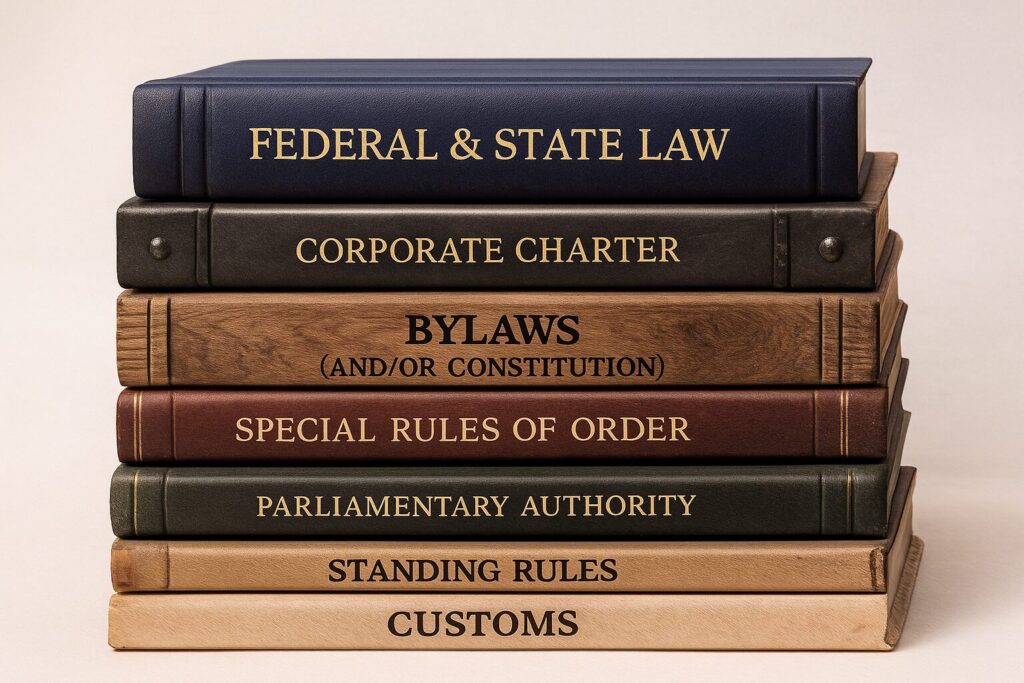Understanding the Hierarchy of Governing Documents in Board Meetings

When conducting a board meeting—whether it’s for an HOA, nonprofit, or other organization—it’s critical to understand which rules take precedence when interpreting decisions, enforcing procedures, or resolving disputes. Under Robert’s Rules of Order, Newly Revised (RONR), there is a well-defined hierarchy that determines which governing document or authority controls in any given situation.
Let’s break it down step by step:
1. Federal & State Law – The Supreme Authority
At the very top of the hierarchy is the law of the land. This includes:
- Federal laws (e.g., Fair Housing Act, ADA)
- State statutes (e.g., Nonprofit Corporation Acts, Condominium Property Acts)
- Local ordinances
🛑 Nothing in your documents or meeting procedure can override applicable law. Even if your bylaws or rules say otherwise, they must yield to legal requirements.
2. Corporate Charter
Also known as the Articles of Incorporation, this foundational document:
- Legally establishes the organization
- Defines its name, purpose, and sometimes its powers or limits
If there’s ever a conflict between the bylaws and the charter, the charter controls. Think of it as your organization’s birth certificate.
*Declaration of Condominium (or CC&Rs)
- Filed in the county land records (not the state corporate office).
- Acts as a legal covenant running with the land.
- Defines:
- Property boundaries
- Unit/common area definitions
- Ownership interests
- Restrictions (e.g., use, rentals, pets)
- Maintenance responsibilities
- These are binding on all current and future unit owners and cannot be easily amended without owner votes.
In practice, the Declaration usually carries more legal weight in a condominium association than the Articles of Incorporation.
3. Bylaws (or Constitution)
Your Bylaws are the primary operating manual of the organization. They typically include:
- Membership qualifications
- Officer roles and elections
- Meeting frequency and quorum rules
- Voting rights
- Committee structure
RONR reminds us that no standing rule, policy, or custom can contradict the bylaws. Only an amendment (adopted properly) can change them.
✍️ In organizations with both a constitution and bylaws, the constitution is treated as a higher-level document than the bylaws, unless the documents say otherwise.
4. Special Rules of Order
Special Rules of Order are adopted rules that modify or supplement the organization’s parliamentary authority (like RONR). These might:
- Change how motions are handled
- Set time limits for debate
- Restrict the use of proxies
These are adopted by the membership (not just the board) and must not conflict with the bylaws.
5. Parliamentary Authority (e.g., Robert’s Rules of Order)
If your bylaws say “The rules contained in Robert’s Rules of Order shall govern…,” then RONR becomes your official parliamentary authority. This fills in the blanks where your bylaws are silent.
But RONR only applies if no higher rule (law, charter, bylaw, or special rule) addresses the matter.
6. Standing Rules
Standing rules are administrative or procedural guidelines adopted by the organization or board. Examples:
- How late members may enter a meeting
- Rules for submitting agenda items
- How minutes are formatted
These rules can be adopted or suspended by a simple majority and must never conflict with higher documents.
7. Custom
Last and least is custom—the “we’ve always done it this way” approach.
RONR acknowledges custom, but it can never override a written rule or authority. And once the assembly adopts a formal rule that contradicts a custom, the custom is effectively abolished.
Why This Hierarchy Matters in Board Meetings
When a conflict arises—say, someone proposes a new meeting procedure, or there’s disagreement about a member’s voting rights—the chair, the board, or a parliamentarian must evaluate:
- Is this covered by law?
- Does the charter address this?
- What do the bylaws say?
- Are there adopted rules or policies?
- What does Robert’s Rules prescribe?
- Is this just tradition, or is there a rule?
🚨 Following the hierarchy ensures that decisions are valid, fair, and defensible—especially when challenged legally or procedurally.
Final Thoughts
Knowing which rule applies—and when—is a powerful skill. It protects your organization from costly mistakes and ensures your board operates with transparency, structure, and respect.
If you’d like help interpreting or writing your bylaws, adopting special rules of order, or running meetings properly, don’t hesitate to reach out.
